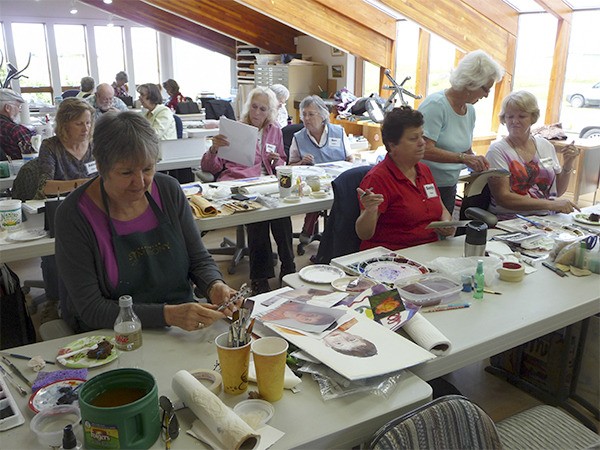A cadre of Sequim’s avid watercolorists gathered at Straitside Studio for a five-day workshop with nationally and internationally recognized artist Stan Miller of Spokane, who’s been supporting himself with his art for more than 30 years, painting between 20-100 works yearly.
“He’s an excellent watercolorist and getting him to come here speaks to the quality of the artists on the peninsula — that we can bring in artists like Stan,” said Madeline Bryant, a workshop participant.
Miller’s visit, from June 23-27, was sponsored by North Olympic Watercolorists and his workshop topic was “Portraits & Landscapes.” He presents four or five workshops a year. In early June, he was one of three American watercolorists to be invited to an international watercolor exhibition and forum by the Thailand Commission of Contemporary Art in Bangkok. Part of a group of 20 artists from around the world to be so honored, Miller painted and taught budding watercolorists in several Thai cities. He’s also presented workshops in France and Trinidad. Between 1985 and 2014, Miller has picked up award after award, including many for “Best of Show” pieces. Between 1979 and 2000, he’s had five one-man exhibits in the U.S.
Miller’s works are almost photographic, with keen detail woven into renditions of his subjects.
“I’m a realist and paint portraits and landscapes primarily,” Miller said. “I work from photos, my imagination and live models and paint in plein air or onsite. Art is language and because it’s a language I use it to communicate. Like a musical instrument, it’s a different way to communicate than just words. Art is a way to share what’s going on inside of me.”
Miller said mastering the techniques of watercolor probably is no more challenging for beginners than learning how to paint with oils or acrylics.
“The most difficult part of what I do is not the watercolor. The most difficult thing is deciding what I want to say and how I want to say it,” Miller said. “It’s a craft I love, using watercolor. The art is how do you use your craft? When I try to interpret life, the more effectively I do that, the more it’s art.”
He’s inspired by his perception of a world of beauty surrounding him.
“It strikes me as something that visually stirs me and that could be anything.”
The day of the interview, Miller was teaching the 18 students the fine art of portraiture in a work featuring an old black gentleman. Miller’s realism was so true that you could reach out and “feel” the coarseness of individual hairs in his white beard. Miller’s ability to create texture in his watercolors is one of his chief characteristics.
“Stan’s approach is to put it (watercolor) on now as you want it the first time,” said Carol Wilhelm, another participant.
It took several tries and a number of years before Miller embraced painting watercolors as a career, eventually succumbing to its allure.
“I was influenced by my older brother Greg when I used to watch him draw. I took watercoloring the first year in college and I didn’t like it,” Miller said. “I took it again my last year and ended up loving it — the difference was by then I’d had three years of training in all aspects of art and I knew more of what I was doing.”
Miller graduated from Spokane Falls Community College in 1973 with an associate degree in applied science and a professional diploma in art.
He lives in Spokane and paints full time, teaching workshops on the side and selling to private and public collectors — whoever wants to buy them, he said. Asked when he realized his career as an artist took off, he quipped, “It’s still taking off!”
There’s always an upside and a downside to every career. The best part is, Miller said, “If I could do anything in the world, there’s nothing else I’d like to do. It satisfies me and makes me feel very free — free to follow my dreams, my loves and my heart.”
If there’s a worst part about being a professional watercolorist, Miller doesn’t see it.
“For some people, they wouldn’t enjoy not knowing what their income is going to be because they don’t have a regular income but I like that — the insecurity makes life more exciting.”


